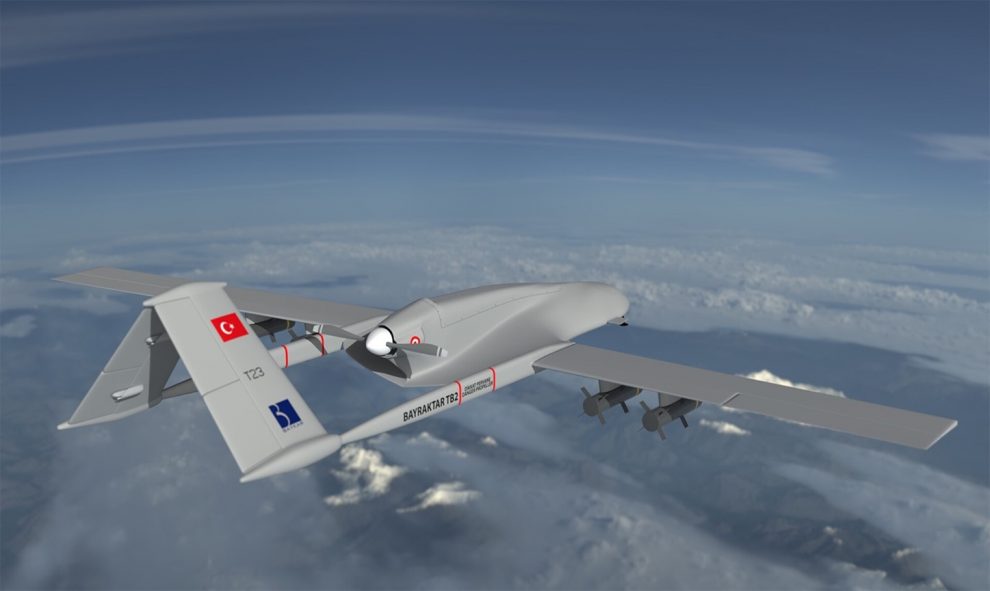Between 2018-22, Türkiye’s global share in arms trade rose from 0.6 percent to 1.1 percent, making the country the 12th biggest arms exporter globally.
Türkiye’s defence industry has been growing at its fastest pace for almost two decades, and two recently released reports reveal what level the country’s arms industry has reached.
The Top 100 Defense Companies List 2022 – the annual listing by the global news website Defense News – has three Turkish companies in the top 100. While Aselsan was 49th on the list, Turkish Aerospace Industries (TAI) was 67th, and Roketsan was placed 86th.
In 2020, the list had seven Turkish companies. Although fewer companies are listed in the Top 100 now, Türkiye’s arms exports grew sharply within three years. While defence exports were $2.28 billion in 2020, they rose to $4.3 billion in 2022.
On the other hand, a report on international arms transfers in 2022, prepared by the Sweden-based SIPRI institute, shows that Türkiye’s arms exports increased by 69 percent in the four-year period 2018-2022 compared to 2013-2017.
Türkiye’s global share in arms trade rose from 0.6 percent to 1.1 percent in 2018-22, making the country the 12th biggest arms exporter globally. Additionally, imports dropped by 49 percent when the two periods were compared.
As the sector grows in uncertain times globally, Turkish defence companies will see ups and downs in performance. Yet, the industry’s gradual growth is almost inevitable.
While Turkish companies supplied only 20 percent of the army’s military equipment in 2004, the figure rose to a whopping 80 percent in 2022.
This positive change was due to the Turkish government’s decision to indigenise the arms industry in the early 2000s. Since then, Turkish companies have produced rifles, armoured vehicles, portable surface-to-air missile systems or MANPADs, artillery units, various missile types with ranges of up to 1000 km, helicopters, propelled light attack jets, and most importantly, advanced armed drones, whose reputation has reached all parts of the world.
On the flip side, Türkiye is now on the verge of producing fighter jets, tanks and howitzers, which can generate more revenue. As per producer companies’ statements, all weapons that are difficult to be produced will be in use by 2028.
Earlier this month, TAI rolled out its most advanced armed drone Anka-3, the light attack and training jet Hurjet, and its 5th generation TFX jet.
Parallel to aircraft development, TAI’s subsidiary TEI, the engine-producing company, will test its 6000 lbs. thrust engine within this year and simultaneously start working on a 35.000 lbs. thrust engine for TFX, which is expected to be ready by 2028.
On the other hand, armoured vehicle maker BMC will deliver two Altay tanks to the Turkish army in April and begin mass production in 2025. BMC solved the engine problem by procuring it from South Korea until it can use its 1500 HP power engine, Batu, in 2026.
Turkish missile, ship, drone, vehicle and military software producers are also marketing their products, which do not require foreign parts.
Reports say that Aselsan, the biggest defence company in Türkiye, has a backlog of almost $7.6 billion. BMC has orders for two years for its Kirpi mine-resistant vehicles. Baykar Tech has also asked its customers to wait a few years to receive their drones.
In addition, BMC says that many countries are looking forward to buying Türkiye’s indigenous tank Altay. Also, another sales boom is expected to be witnessed when TFX jets are flying in the sky. As a final example, Roketsan has achieved to produce surface-to-air missiles that hit the target at a distance of 150 kilometres.
From a general point of view, Türkiye has climbed in statistics regarding the defence industry with its smaller and low-cost weapons, most of whose parts are produced in the country.
For instance, Turkish drone and missile producers are so self-sufficient that foreign embargoes can no longer halt their production.
Therefore, they are free to produce and market their weapons in the international market. Thanks to indigeneity and the quality of their weapons, Türkiye could become a significant arms exporter with more than $4 billion in revenue.
For instance, while an armoured wheeled vehicle’s price is $500.000, an Altay tank can be bought for $15 million. Likewise, while a Bayraktar TB2 drone goes for $5 million, the brand-new Kizilelma drone will cost at least $30 million. Finally, the TFX jet’s cost is expected to be $100 million. This means that selling just 40 units of TFX fighters will bring the same revenue as Türkiye’s current defence exports.
It can be concluded that Türkiye may soon be in the top 10 arms exporters and hit the $20-billion export revenue within ten years. Thus, besides being self-reliant in arms acquisition, it will generate new jobs and revenues, not to mention the impact on Turkish foreign policy.
The Turkish defence sector has already entered the global race. Therefore, it is inevitable that the companies will keep the country in the top league of arms producers and sellers.
Source: TRT World






